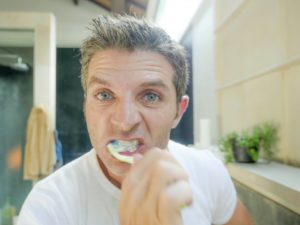If you’ve ever talked to the dentist, you know that brushing and flossing your teeth every day is the best way to maintain oral health. However, did you know that according to the Wall Street Journal, up to 20% of the world’s population have damaged their teeth or gums due to abrasive brushing habits? Many of these people most likely started doing this as children, and as a result of learning the wrong way, it carried into adulthood. The good news is, your Dublin dentist can help you identify if you’re brushing too hard so that you can adjust your method before causing harm.
How to Know if You’re Brushing Your Teeth Too Hard
Before it gets the chance to turn into tartar, plaque is actually extremely soft and easy to remove, which is why it’s important to brush regularly. It might seem like cleaning your teeth with a toothbrush is the same as cleaning a surface with a scrub brush, however, brushing harder doesn’t necessarily equal cleaner teeth. If you’ve ever felt like maybe you’re brushing your teeth too hard, here are some tell-tale signs that can help you know:
- Sore or Bleeding Gums: When you over-brush your teeth, the bristles can cause lesions on your gums. This can eventually lead to gum recession, which often results in disease from the infiltration of bacteria.
- Severe Wear on Tooth Enamel: Believe it or not, the bristles of your toothbrush have the power to deteriorate the enamel on your teeth over time if used too harshly. This can cause the teeth to weaken and be more susceptible to breakage and decay. If you often have cavities or cracks in your teeth, you likely need to lessen up on your brushing pressure.
- Sensitivity: Many people struggle with sensitive teeth, however, if yours are excessively tender, it may be a sign that you’re brushing too hard. Your dentist can examine your teeth and help you identify if that is the cause.
Your teeth may be the hardest bones in your body, but they’re not invincible. If you think you’ve gotten into the habit of brushing your teeth too hard, there’s still time to adjust and keep them from incurring any more damage.
What Does Proper Teeth-Brushing Look Like?
Now that you know how not to brush your teeth, you may be wondering what the proper technique looks like. Here are some tips to help you keep your teeth both clean and in great shape:
Get a Soft-bristled Toothbrush
This is one of the easiest methods to help hard brushers ease back. Softer bristles make it nearly impossible to brush with excessive pressure, which keeps your gums safe and your tooth enamel from eroding.
Brush at a Forty-Five Degree Angle
In order to protect your gums from excess pressure, you can position the head of your toothbrush at a forty-five degree angle to the gumline when you are brushing your teeth. This may be something that is easier to grasp when demonstrated, and your dentist can help you with that.
Use Shorter Strokes
Instead of sawing back and forth against your teeth with long aggressive strokes, try using shorter, more gentle ones. This will naturally cause you to brush more softly.
Pay Attention to How Much Pressure You’re Applying
If you notice the bristles fraying and wearing out quickly, causing you to have to replace your toothbrush more often, this could be a sign that you are applying too much pressure when brushing.
If you feel that you may be brushing your teeth too hard, the most important thing you can do is be mindful while you are doing it. As long as you are purposefully applying the proper techniques, you’ll find that you can develop a new habit to keep your teeth healthy in no time!
About the Practice
The team of experts at Distinctive Smiles is passionate about helping each of their patients maintain oral health by teaching them how to properly care for their teeth. With years of experience in helping people learn proper brushing techniques, they can provide the knowledge and tools that you need to have a beautiful and healthy smile. If you’re ready to get your teeth in tip-top shape, schedule a consultation online or call (614) 792-1800.

